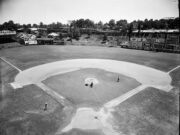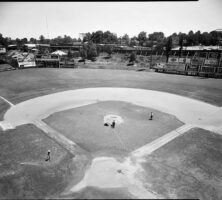The Atlanta Black Crackers played in the Negro Southern League and the Negro American League during the early to mid-twentieth century. Like other Black teams, they were never recognized by professional organized baseball, and the only reliable records of their experiences are primarily from the players themselves and from newspaper accounts.
Nineteenth-Century Origins
In 1867 the National Association of Baseball Players officially banned Blacks from playing in its all-white league. In 1887 the League of Colored Baseball Clubs was formed. During the same decade, Black baseball began in Atlanta at Atlanta University and Clark University (the schools would later merge to become Clark Atlanta University), as well as at other local colleges.
Atlanta’s first Black professional team, the Deppens, began touring the South before the turn of the century. The Deppens eventually were succeeded by the Atlanta Cubs, a semiprofessional team of Black college students.
Negro Southern League
The Cubs changed its name to the Atlanta Black Crackers during the summer of 1919, the same summer in which twenty-five violent race riots occurred across the country. The team became the Black Crackers simply because many fans were already using the name, which referred to the Atlanta Crackers, a white team. Local restaurateur Bill Shaw was the Black Crackers’ owner.
In March 1920 the team joined the Negro Southern League, made up of the Birmingham (Alabama) Black Barons, Jacksonville (Florida) Red Caps, Montgomery (Alabama) Grey Sox, Memphis (Tennessee) Red Sox, Nashville (Tennessee) Elite Giants, and New Orleans (Louisiana) Crescent Stars. The Black Crackers stayed in the league and represented the city through 1937. The Black Crackers and other teams in the Negro Southern League were generally considered to be farm teams associated with the Black leagues that operated nationally.
Negro Southern League franchises were never financially stable. Visiting and home teams furnished two balls per game, and often games had to be stopped to retrieve the balls. Because the teams carried only about twelve players, the athletes played more than one position, and membership on the teams changed constantly. Relief pitchers were nonexistent, and pitchers moved to the outfield to finish games after pitching a few innings.
Barnstorming provided a way for the Black Crackers and other Black baseball players to supplement their incomes. Teams often traveled thousands of miles each year by car, bus, or train to play in small towns on the barnstorming circuit, where they received enthusiastic welcomes. The Black Crackers traveled in buses that frequently broke down en route.
Through their travels the Atlanta Black Crackers played against such legendary baseball players as James “Cool Papa” Bell and Satchel Paige, and against such teams as the Chicago (Illinois) American Giants, Homestead Grays, House of David, Indianapolis (Indiana) Clowns, Kansas City (Missouri) Monarchs, and Zulu Cannibal Giants.
When at home the Black Crackers played at Ponce de Leon Ballpark, home of the Atlanta Crackers, while the white team was away on road trips. Other times they played at Morehouse College and Morris Brown College. The team’s uniforms, bats, baseballs, and other supplies were donated by the white Crackers and others.
Negro American League
The zenith of the Negro National League, which was founded in 1920, came in the late 1920s, as major Black players commanded salaries of more than $350 a month, a much higher wage than most African Americans earned at the time. The Great Depression destroyed their prosperity, however, and in 1933 a new Negro National League was formed, while the Negro American League was chartered in 1937. These two leagues thrived until Jackie Robinson integrated major league baseball in 1947. The national Black leagues played eleven world series and created their own all-star game, which became the biggest Black sports attraction in the country.
In 1937 the Reverend John Harden and his wife, Billie, owners of Harden’s Service Station on Auburn Avenue, bought an interest in the Atlanta Black Crackers, and the following year the Hardens purchased the team outright from owner W. B. Baker. Also in 1938 the Black Crackers merged its Negro Southern League franchise into the Negro American League. After winning the second-half season title, the Atlanta Black Crackers were set to play the Memphis Red Sox for the Negro American League championship. Neither team wanted to play in the other’s ballpark, however. The Black Crackers had lost eight straight games in Memphis, while the Red Sox had lost five in a row in Atlanta. The teams played two games before the Negro American League president declared the series a no-contest.
In 1939 the Atlanta Black Crackers franchise moved to Indianapolis, where they played in the Negro American League under the nickname ABCs. A new Atlanta Black Crackers team rejoined the Negro Southern League in 1940.
Integration
Near the turn of the twentieth century, American Blacks began playing in Cuba during the winter months. Black baseball players tested themselves against Cubans and white Americans, who also sought Latin American paychecks. At the time baseball was integrated in 1947, African American players had the option of playing in many different Caribbean countries. They not only earned good salaries but also enjoyed life in integrated societies, where they played alongside white teammates as equals.
The integration of major league baseball signaled the end of the Negro leagues and the Atlanta Black Crackers. The Negro National League folded following the 1948 season, and although Black teams continued to play for several years, they were no longer of major league caliber. The demise of the Black leagues was inevitable as younger Black players were signed by major league franchises.






